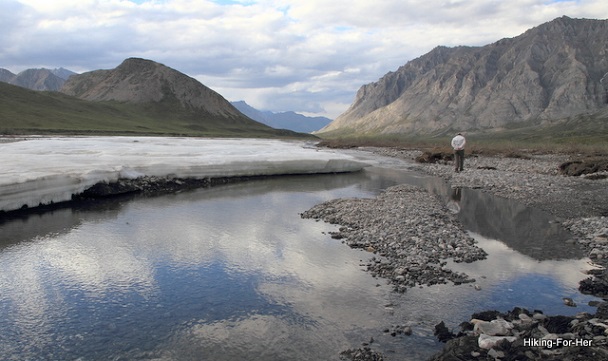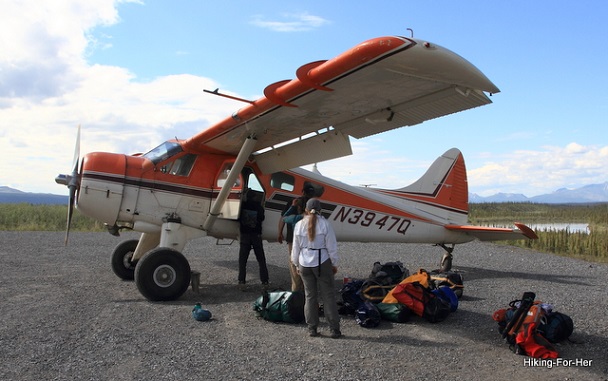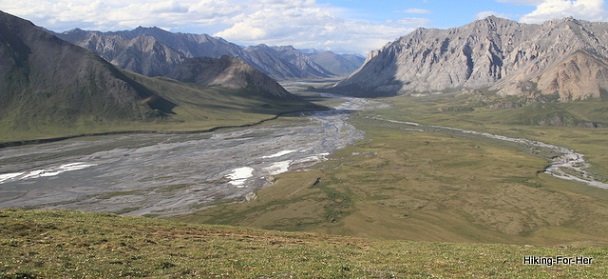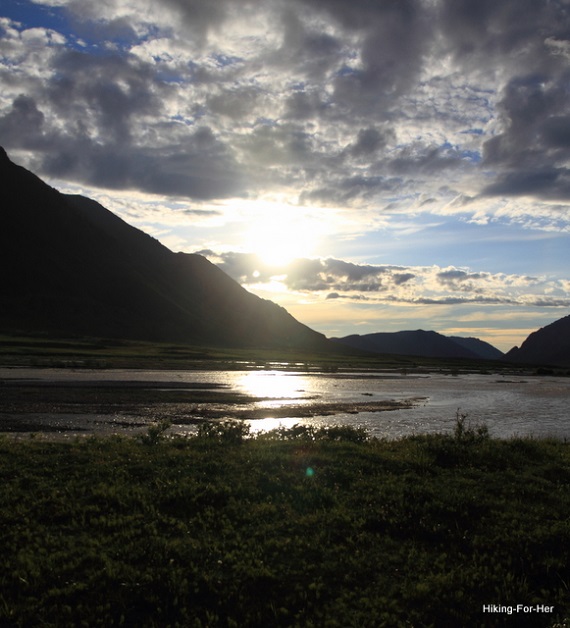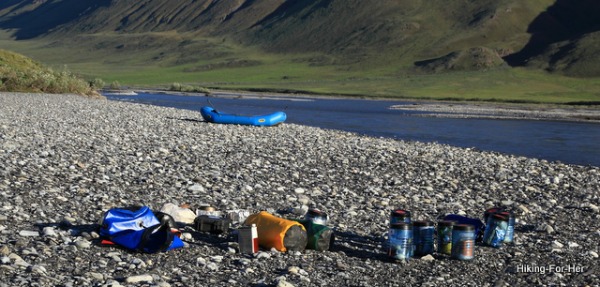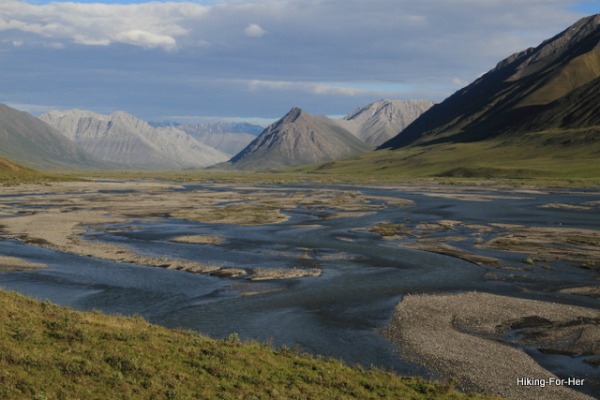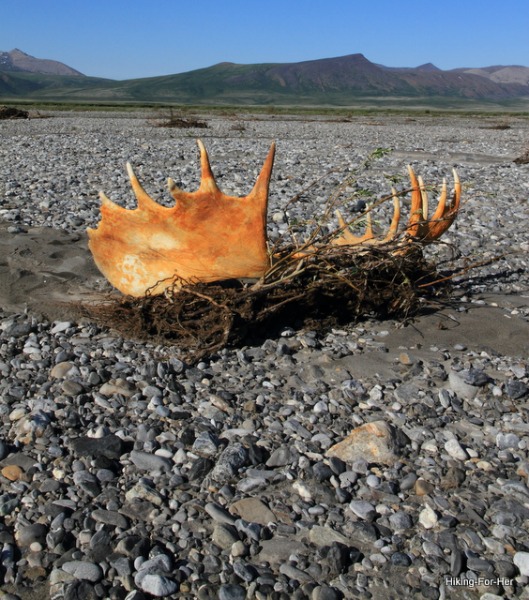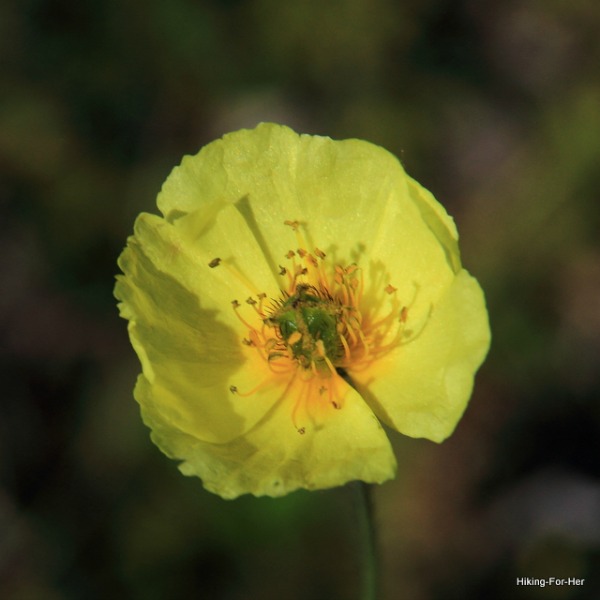
ANWR Hiking and Rafting:
It's Wild!
By Diane Spicer
ANWR hiking and rafting?
Just another way to say WILD ADVENTURE!
If you're looking for my detailed ANWR gear list, go here.
If you're searching for a first hand description of what it's like to ride a wild river from its source to the Arctic Ocean, keep reading.
Why an ANWR
hiking and rafting trip?
Every summer I try to visit a location on the planet which offers solitude and ruggedness in large doses.
This time around, I think I nailed it: the Artic National Wildlife Refuge (ANWR, or "the Refuge").
Why is this such a special place?
- No roads or cell phone towers
- No humans, or even signs of humans
- Grizzly bears going about their daily business
- No way out except your own muscle power: over land, on the river, or a combination of your own choosing - thus, ANWR hiking AND rafting
How to get a taste of ANWR
Read any of these books, and you'll begin to get a taste of what makes the Arctic National Wildlife Refuge such a fantastic region of the world.
Where Mountains Are Nameless by Jonathan Waterman (with excellent bibliography)
Two in the Far North by Margaret E. Murie
Being Caribou by Karsten Heuer (also available as a DVD with amazing visuals)
Arctic Dreams by Barry Lopez
ANWR as a political hot potato
For those who haven’t been there, ANWR is not on your radar at all, or it's a political concept:
- Drill it?
- Preserve it?
- Ignore it?
Read a few of those books I mentioned above to also gain a sense of what's at stake in the Arctic.
Now a veteran of an ANWR trip, I see it as the last place in the United States we haven’t completely messed up with ambition, greed, hubris, or any of the other unattractive attributes of humans.
And I refuse to read one more word, or listen to one more sound bite, by anyone (politicians, pundits, and the like) who hasn’t been there.
And that comes down to less than 1000 people a year.
Who are these ANWR travelers?
River runners & hikers (like me), but also hunters and field scientists.
And the busy bush pilots, of course. No one goes anywhere without them!
ANWR's mighty (and wild) rivers
Words alone cannot paint an accurate picture of ANWR hiking and rafting.
Instead, imagine 19 million acres (about the size of South Carolina).
No roads, no trails, no towns...
You can immediately understand why traveling by river is the most efficient way to see this vast back country.
And here's the good news: You can take your pick of many mighty rivers, with names that are fun to chant as you paddle your raft past the towering mountains of their origins.
Try a few on for size:
- Hulahula
- Kongakut
- Sheenjek
So with such an embarrassment of river-y riches, which river to choose?
How about the Canning River, at least this time around?
- It's only Class III in very short stretches (and only after heavy rain), so most of the trip is an easy-to-manage Class I or Class II.
- Perfect for folks without a paddling background, or for those wishing to focus on hiking and wildlife observation.
ANWR trip logistics
The planning for this adventure began 6 months in advance, by communicating with Carl, owner of Expeditions Alaska.
Here’s
his description of a past ANWR hiking and rafting trip. Note that he provides his own version of an ANWR gear list, but I urge you to read mine as well for comparison.
The July 2014 adventure commenced with a flight from
Fairbanks on a small plane.
- It felt more like a bus ride than a plane, as we delivered goods and people to points along the way before jumping off at the last stop: Arctic Village.
At the Village, we waited for another bush pilot to deliver us to the headwaters of the Marsh Fork, deep in the Brooks Range.
- Turned out the water levels were too low at the headwaters, so we flew down the river a bit to a convenient landing strip surrounded by nameless mountains.
There, we dumped our gear (including a deflated raft and 4 paddles) out of the plane, waved adiós to the pilot, and had a look around.
In every direction, hiking possibilities beckoned.
And the river was waiting to carry us to even better hiking destinations.
That, my friends, makes for a very good day!
ANWR hiking and rafting objectives
Our ANWR objectives: To paddle down the Marsh Fork (on the left in this photo) to the confluence with the Canning River (several days away), hiking wherever possible and remaining alert for animal encounters.
Paddling would continue on the Canning to the Arctic Ocean (ok, the Beaufort Sea to be technically correct), where we would be picked up by a bush plane and returned (reluctantly) to “civilization” in Coldfoot (famous for its northernmost truck stop on the Dalton Highway).
We had 12 days to paddle & hike these 140 miles of river, plenty of food, proper gear, and fair weather (at least on Day One).
Let’s get started!
Not so fast.
- Bush planes land on tiny little landing strips above the river.
- We (our river guide Jule, myself, my husband David, and Russell from California = 4 humans on the trip) had to portage the now-inflated raft and all the gear down to the river, over tussocks and willow tangles & through cold fast streamlets.
- That took much effort and time, but finally we launched our trusty raft.
It felt great to get our ANWR hiking and rafting trip under way!
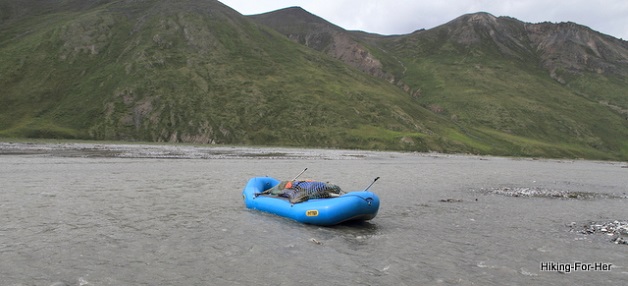 Our inflatable raft containing all of our belongings, safely (?) beached on a gravel bar in the Canning River
Our inflatable raft containing all of our belongings, safely (?) beached on a gravel bar in the Canning River
River Time!!!
Class I and II, with a bit of Class III thrown in after a rainstorm, made for easy going.
I’ve done a lot of canoe paddling and I must say the raft was way more comfortable and the paddling easier with 2 people in the back.
Under the expert direction of our river guide, we fell into a soothing river rhythm, slipping along with the current - until we had to get out of the loaded raft to push it over shallow gravel bars.
- Cold feet and sometimes exciting jumps back into the raft without losing a paddle kept things lively.
- And watch out for those deep holes!
Day and night were indistinguishable in the far North, just a week after Summer Solstice.
Clock time meant nothing, as we ended up hiking at midnight (as in this photo below), napping at noon, eating whenever hunger struck.
Immense sky,
towering nameless mountains slipping by,
brilliant sunshine,
bird calls and
murmuring river water became our reality.
Empty mind, full heart.
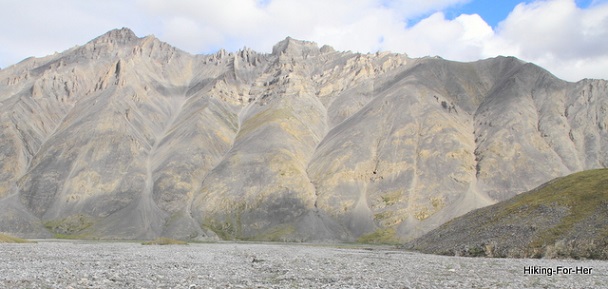 Can't you just feel the sun baking these hills?
Can't you just feel the sun baking these hills?Words became irrelevant.
Just soak it all in: the real objective of ANWR hiking and rafting.
Physical space created mental space, enlarging my ability to remain peaceful, to stop thinking (What time is it?) and judging (I’m cold/hot/hungry/sore/tired).
It gave me time, precious off-the-clock time, to inhabit animal awareness – such a fond memory of ANWR hiking and rafting.
Animal encounters
Speaking of animals, I learned to embrace the reality that my normal role as human predator could reverse quite suddenly, making me prey.
Small scale prey for mosquitoes – no big deal; bug nets and repellents even the score.
[Full disclosure: some mental toughness is also required when they cover you from head to toe!]
Brown (grizzly) bears? Quite a few orders of magnitude larger.
Bear signs were evident at several of our camps: prints, scat, diggings.
We took full precautions:
- kitchen area located far from tents,
- bear canisters for food storage (lower right in photo below),
- carrying bear spray while on land,
- frequent scans while hiking for the distinctive brown livingness that becomes a bear foraging on the landscape.
Did we actually see a brown bear?
Oh yes, but in the best possible way: as we were gliding safely down the middle of the Canning River.
- The immense beast scrounged through the vegetation on a raised river bank, not even noticing our bright blue raft.
- Sunlight glinted off its fur, outlining it in golden rays, making it seem otherworldly.
(NOTE: There are no photo ops on the river - too risky for the cameras and not a great idea in terms of paddling. What happens on the river, stays on the river: just one more ANWR hiking and rafting memory. So no brown bear photo for you.)
Also, I was lucky enough to cross paths with a red fox at one camp spot.
It had given away its presence earlier in the day: little foot pad impressions on the softest spots along the beach, deliberately avoiding all rocky areas.
I nicknamed it Tender Foot Fox!
Constantly changing terrain
The terrain and weather changed as we approached the confluence with the Canning River.
The mountains became a bit more rounded, the air drier.
We were leaving the Brooks Range, heading out into flatter terrain.
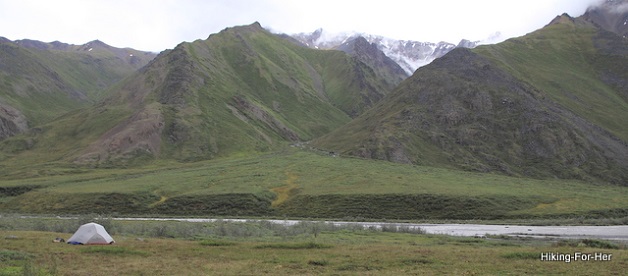 Peaceful campsite among rounded hills as we head toward the ocean
Peaceful campsite among rounded hills as we head toward the oceanOnce on the Canning River (the water coming in from the right, at the confluence of the Marsh Fork and the Canning in the picture below), the mountains began to recede into the distance.
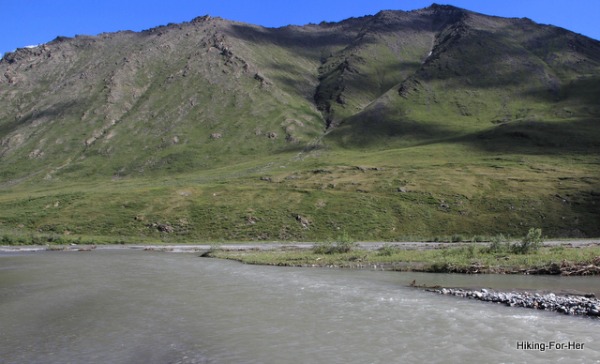 Wider river, big green hills
Wider river, big green hillsVistas opened up.
The river was much wider, with more wind (and thus harder paddling) in our faces as the day lengthened.
Getting off the river in mid-day became the norm, with time for napping and exploring.
Eventually, ANWR hiking and rafting became only ANWR rafting - unless you had the energy to walk for miles across uneven terrain before reaching a mountain for a big view!
This view looks south, toward where our journey began on the Marsh Fork (at the foot of the mountain in the middle).
See what I mean?
Lots of river miles behind us!
And can you get a sense of the challenge our river guide was up against on this ANWR hiking and rafting adventure?
As the days melted into one long fusion of sun, wind, and water, the terrain flattened out completely.
I missed the mountains, but there were many other things to hold my attention! Take a look at a few diversions:
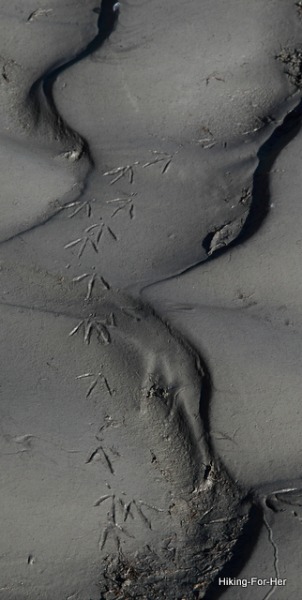 So many birds congregate along the river!
So many birds congregate along the river!More river miles behind us, and the mountains were gone, replaced by a vast flatness.
Note the foggy skies - getting close to the Arctic Ocean!
Also note the remnants of ice - in July! Time to dig out the fleece scarves and down jackets.
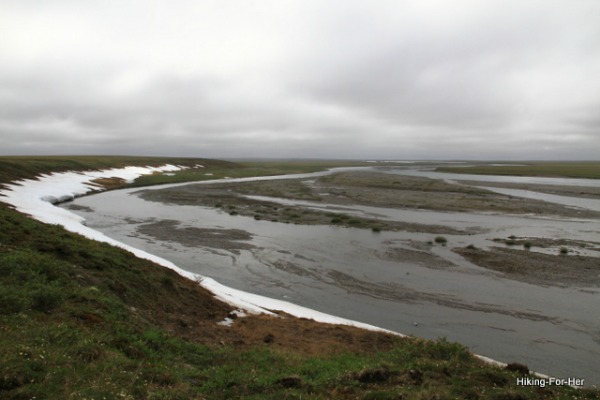 Brrrr...Arctic Ocean breezes
Brrrr...Arctic Ocean breezes
An abrupt, unplanned end to the trip
Although restful mentally, this ANWR hiking and rafting trip took its toll on me physically.
Not so much the daily paddling, which I had prepared for by daily weight lifting for 6 months prior to the trip.
Instead, it was the constant bright light and daily wind exposure that caused eye fatigue. By Day 5 on the river, severe erosions of my conjunctiva (white part of the eye) took away vision in one eye.
Scratchy, uncomfortable eyes, paired with the mental anxiety of not knowing if my vision would be damaged permanently, began to wear away at my river calmness.
As a result of my eye problems, we cut our trip short by a few days. Luckily, a landing strip was available on one of the river banks before we reached the Beaufort Sea.
So we didn't paddle the Staines ("steenes") River as originally planned, to take out at the ocean :(
Two plane rides later, I was in the Fairbanks emergency room.
- No permanent eye damage.
- But a bucketful of fantastic ANWR hiking and rafting memories!
Does ANWR tug on your
hiking heart?
Each of us goes to the wilderness for a reason.
For me, it’s solitude and an opportunity to become a silent witness to, and participant in, nature.
What’s your reason?
If you’re interested in an ANWR hiking and rafting trip, check out my gear list.
You'll be well prepared for changing weather conditions and big views like this one!
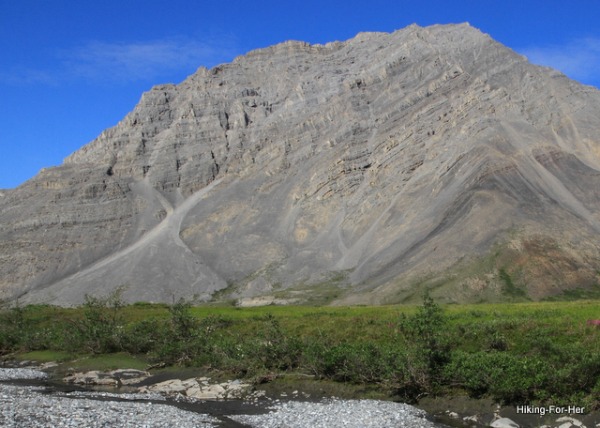 You can see Mother Earth's bare bones while ANWR hiking and rafting.
You can see Mother Earth's bare bones while ANWR hiking and rafting.ANWR Hiking and Rafting
|
I get emails all the time about what I wear, eat, carry and love to use on the trail. That's
why I provide affiliate links to you: the best gear that I use myself and have seen used by other hikers is instantly
available for your consideration, and the gear company sends a few
pennies per dollar to this reader-supported hiking website. There is no added cost to you! Everyone ends up a winner: Great gear for you, strong gear companies, and more free hiking tips for everyone. Thanks very much for your support. It's warmly and sincerely appreciated. It also helps send these hiking tips to all your virtual trail buddies around the globe. |
 |
